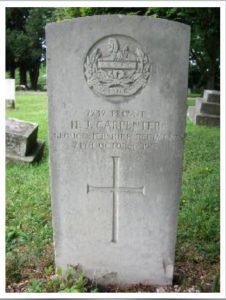1st Battalion, Gloucestershire Regiment

Henry James Carpenter was born at Tredworth, Gloucester in the first half of 1883. The parents were James Carpenter (1855-1922), a farm labourer and his wife Eliza (née Ackley: born 1853). They had had seven children, of whom six were living at the time of the 1911 census. Henry was the second eldest and the elder of the two boys.
In 1901 the family lived at 73 Green Lane, Hucclecote, Gloucester; both James and Henry were employed as horse drawn cart drivers on a farm. By 1911 Henry was living at 42 Great Western Road, Gloucester, along with Annie (described as his wife — see below) and two children. His occupation was as a horse driver.
Henry enlisted in the Army on 28 September 1903, signing on for three years ‘with the colours’ and nine in the Reserve. He joined the Gloucestershire Regiment (number 7232) and after a period of training was posted to 2nd Battalion on 7 June 1904. He served until 26 September 1906 and on the following day entered the Reserve.
He was still a Reservist when war broke out in August 1914 and was mobilised on August 5th and posted to the 3rd (Reserve) Battalion. He transferred to the 1st Battalion (part of 3 Brigade, 1st Division) on 26 May 1915, when he was posted to the British Expeditionary Force in France. The battalion War Diary for the 1st Glosters records the arrival of a draft of two NCOs and 58 Other Ranks on 30 May 1915, when it was in the front line at Vermelles.
On 25 September 1915 the British attacked the German lines near the mining town of Loos-en-Gohelle. To support the attack the British Army used chlorine gas for the first time, not totally
successfully. 3 Brigade was part of the Divisional Reserve and came into the attack later that day. The German lines ran to the west of the Lens – La Bassee Road. During the attack Private Henry Carpenter suffered a gun shot wound to his right arm and leg. He was taken to No 1 Field Ambulance and on 1 October admitted to 3rd Canadian General Hospital at Camiers. He was repatriated to England on 6 October.
He was eventually discharged from the Army on 14 May 1916 as being no longer physically fit for war service. A report of a medical board stated that the muscles of his right arm and side had been torn away and his right arm was almost useless. He was granted a 50% disability pension and a Silver War Badge, to denote discharge from military service.
It is not known whether Henry was able to return to any form of employment in the almost two and a half years between leaving the Army and his death, on 24 October 1918, aged 35. The cause of death is not known. He was buried in the churchyard of St Lawrence, Barnwood on 28 October, where a standard CWGC headstone marks his grave.
Henry left a widow, Margaret Annie (née Jones). According to the Census taken in 1911, they had been been married for three years and had two children. However, there is no evidence in the Birth, Marriages and Deaths Register (BMD) of any marriage taking place in 1908. A surviving Army Pension Record for Henry gives details of a marriage taking place on 4 March 1914 (confirmed in the BMD) and that there were two children, William Henry (born 30 May 1908) and Audrey May (born 8 November 1915). The second child noted in the 1911 Census, as being two months old, was Edward, who died in October 1913. The impression is that Henry and Annie (as she appears to have been known) had a child together in 1908, then lived together until getting married in 1914. The entry in the census was designed to disguise their actual status. A recently released Pension Record Card notes that Annie Carpenter went to live at 3 Industry Cottages, Barnwood sometime after her husband’s death.
Researched by Graham Adams 15th March 2020
